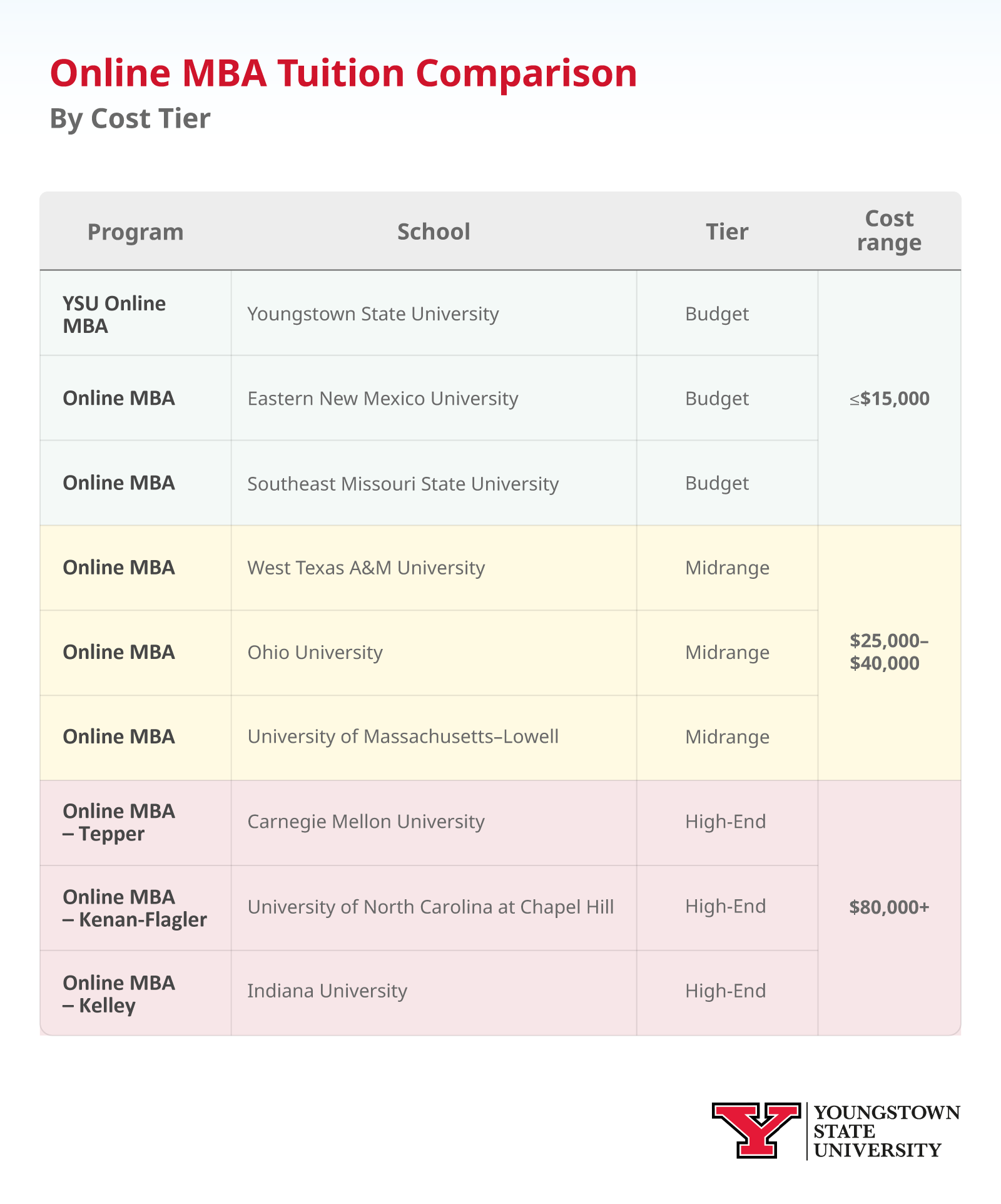
Whether you’re budgeting for your next big move or comparing schools, understanding online MBA tuition is essential to making a smart investment. While some programs top $100,000, others — including accredited, reputable options — remain under $15,000. The key is knowing what drives these differences and how to find the best value for your goals.
This guide breaks down national averages, tuition tiers, cost drivers and return on investment, with examples of affordable, accredited online MBA programs, such as those offered at Youngstown State University (YSU). You’ll also learn how to reduce your out-of-pocket expenses through financial aid, scholarships and tuition assistance programs.
Online MBA Tuition in 2025: National Averages and Ranges
Online MBA tuition costs in 2025 vary significantly based on the program format, delivery method and institution type. Tuition typically includes the base academic fee, technology or online learning fees, and sometimes textbooks or course materials. However, additional costs like transportation, room and board (if hybrid or on-campus), and lost income from full-time study can greatly affect the total financial commitment.
Tuition alone ranges from $18,000 to $88,500 per year, according to Bankrate, depending on the school and program format.
Online vs. In-Person
For online MBA programs, tuition costs are generally comparable to in-person options, ranging between $50,000 and $125,000 total, per Bankrate. While online students may avoid room and board expenses — which can add up to $14,000 per year — they may incur technology fees or travel costs for occasional on-campus requirements.
Full-Time vs. Part-Time
Program type also plays a role:
- Full-time MBAs usually require students to pause their careers, adding lost wages to the cost.
- Part-time students often pay by the credit hour — which ranges from $200 at public universities to nearly $2,000 at private institutions, per Bankrate — while continuing to work, making the academic year more financially manageable.
Public schools typically offer the lowest tuition rates, especially for in-state residents. Meanwhile, private and highly ranked institutions carry higher sticker prices but may offer more robust alumni networks and job placement services.
Program Examples by Cost

Online MBA programs vary widely in total tuition, reputation and delivery structure. Below are examples of programs across three cost tiers — budget, midrange and high-end — each offering different value propositions based on price, accreditation and outcomes.
Budget
These programs cost under $15,000:
- Youngstown State University
- Eastern New Mexico University
- Southeast Missouri State University
Midrange
These programs cost $25,000–$40,000 in total tuition:
- University of Massachusetts–Lowell
- Ohio University
- West Texas A&M University
High-End
These programs cost $80,000 or more:
- Carnegie Mellon University – Tepper School of Business
- University of North Carolina at Chapel Hill – Kenan-Flagler
- Indiana University – Kelley School of Business
Explore how choosing an MBA specialization can shape your career path and increase job market value in this overview of specialization options.
What Affects Online MBA Tuition Costs?
The cost of an online MBA program depends on several key factors, and not all are obvious at first glance. While many students expect online programs to be more affordable, that’s not always the case. Tuition costs are shaped by more than just the delivery method. Here are the most common cost drivers:
- Credit hours required: Programs vary from 30 to 60 credits, with per-credit pricing ranging widely by institution.
- Residency status. In-state students typically pay less than out-of-state learners, though some online programs waive this difference.
- Delivery format: Fully online programs may avoid campus facility fees, but hybrid or low-residency formats can add travel and housing costs.
- Accreditation: AACSB- or ACBSP-accredited programs often charge more due to their rigorous standards and stronger ROI potential.
- Hidden fees: Online students may still pay technology, graduation, library or course material fees, sometimes totaling thousands of dollars.
- Program reputation: Schools with nationally ranked business programs or well-known faculty tend to have higher tuition costs.
- Access to tuition assistance: Programs tied to large universities may offer more institutional aid or eligibility for employer reimbursement.
Even though online MBA tuition may appear lower than in-person programs, it’s important to compare total costs, not just sticker prices. Factoring in time to completion, career interruption and available tuition assistance can make a big difference.
ROI and Affordability: Is an Online MBA Worth the Cost?
For many MBA students, the biggest question isn’t just about tuition — it’s about return on investment. An online MBA degree represents a significant up-front expense, but it can also unlock higher earning potential, better job opportunities and faster career advancement. The key is finding programs where the long-term gains outweigh the initial MBA cost.
In 2023, the average base salary and bonus average base salary and bonus for MBA graduates was $121,324, for MBA graduates was $128,997, with top-ranked schools reporting total compensation close to $200,000. Even mid-tier programs showed strong outcomes, with many MBA students employed within three months of graduation. That means time-to-break-even on tuition can be as short as two to four years for high-value programs.
This chart highlights a clear trend: higher tuition often corresponds to higher starting salaries. While affordability varies widely, schools with more expensive online MBA programs generally report stronger graduate earnings, suggesting that tuition cost may reflect earning potential.

How to Reduce Online MBA Costs: Financial Aid and Employer Support
Online MBA students have several options to manage tuition and lower out-of-pocket expenses. These strategies can significantly reduce costs and make graduate school more accessible:
- FAFSA: Completing the Free Application for Federal Student Aid is the first step toward federal loans and institutional aid eligibility.
- Fellowships and scholarships: These do not need to be repaid and may be offered based on academic merit, leadership, background or career goals.
- Employer tuition reimbursement: Many companies cover part or all of tuition costs for employees pursuing MBAs, especially when tied to career advancement.
- Student loans: Federal and private loans are common tools to bridge remaining tuition gaps. Federal options typically include fixed rates and flexible repayment terms.
- Institutional aid: Schools may offer additional support based on FAFSA results or program-specific funding opportunities.
Youngstown State University’s value-driven MBA tuition model aligns well with these strategies, making it easier for students to maximize financial aid and minimize debt.
Hidden Fees and Total Cost Considerations
While online MBA tuition may seem straightforward, the real total cost can include several overlooked expenses. These can significantly increase what you pay compared to the “sticker price.” Consider these potential costs:
- Books and supplies: Depending on the program and delivery format, textbooks may cost up to $1,200 per year, per Bankrate.
- Technology fees: Many online programs charge fees for virtual platforms, exam proctoring or learning management systems.
- Travel expenses: Hybrid or low-residency programs may require in-person intensives, adding airfare, lodging and meals.
- Graduation and administrative fees: These can add hundreds of dollars to your final semester.
- Course-specific costs: Some classes — especially in analytics or finance — may require paid software or lab access.
Factoring in all these costs is critical when comparing programs. A school of business with low advertised tuition may still result in a higher total cost if hidden fees are not mentioned.
Finding the Right Online MBA for Your Budget
Online MBA tuition varies widely, but affordability doesn’t have to mean sacrificing quality. Today’s online programs give graduate students the flexibility to learn on their own schedule — often while continuing to work — and still see a solid return on investment.
The key is comparing not just base tuition, but total cost, program duration and financial aid options. Accredited programs with transparent pricing, robust student support, and accelerated formats often offer the best long-term value.
Youngstown State University’s affordable online MBA program offerings stand out for the AACSB accreditation, five in-demand specializations and affordable price point for 30 credit hours, making it a smart option for budget-conscious students.
Interested in learning more? Explore YSU’s online MBA programs or contact admissions for personalized cost info and financial aid guidance.
Frequently Asked Questions About Online MBA Tuition
Online MBA tuition is a big decision point for prospective students. Here are answers to common questions that help clarify costs, value and financial options.
What is the average tuition for an online MBA in 2025?
The average tuition for online MBA programs in 2025 ranges from $50,000 to $125,000, depending on the school, credit hours and delivery format.
Is an online MBA cheaper than an in-person MBA?
Not always. While online students may save on room and board, many programs charge similar tuition regardless of format and may include additional tech or service fees.
How much does an online MBA cost per credit hour?
Per-credit costs vary from $200 at public universities to nearly $2,000 at private institutions. The total program cost depends on the number of required credits.
Do online MBA programs offer financial aid?
Yes. Online MBA students are typically eligible for federal financial aid, scholarships and employer tuition reimbursement, just like in-person students.
What factors affect online MBA tuition?
Factors include delivery format, accreditation, residency status, credit requirements, and hidden fees like books or tech support charges.
Are there additional fees beyond tuition in online MBA programs?
Yes. Common extra fees include books, software, tech support, graduation, and any travel costs for hybrid or residency components.
How do I calculate ROI for an online MBA?
Compare total program costs with average post-MBA salary increases. Many graduates recoup tuition within two to four years of completion.
Can employer tuition reimbursement cover online MBA programs?
Yes. Many employers offer tuition reimbursement or direct payment programs for employees pursuing accredited online MBAs.
Is an AACSB-accredited online MBA worth the cost?
Yes. AACSB accreditation signals strong academic quality and employer recognition, often improving job placement and long-term salary growth.
Are there affordable online MBA programs without GMAT requirements?
Yes. Several accredited programs — including Youngstown State University — waive the GMAT and still offer affordable, high-quality degrees.


